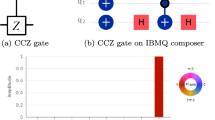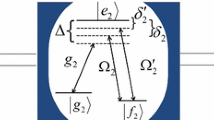Abstract
We propose a scheme for implementation of a universal set of quantum logic gates in decoherence-free subspace with atoms trapped in distant cavities connected by optical fibers. The selective dispersive couplings between the ground states and the first-excited states of the atom-cavity-fiber system produce a state-dependent Stark shift, which can be used to implement nonlocal phase gates between two logic qubits. The single-logic-qubit quantum gates are achieved by the local two-atom collision and the Stark shift of a single atom. During all the logic operations, the logic qubits remain in decoherence-free subspace and thus the operation is immune to collective dephasing.
Similar content being viewed by others
References
Shor PW. Algorithms for quantum computation: Discrete logarithms and factorizating. In: Proceedings of the 35th Annual Symposium on Foundations of Computer Science. Los Alamitos: IEEE Computer Society Press, 1994. 124–134
Sleator T, Weinfurter H. Realizable universal quantum logic gates. Phys Rev Lett, 1995, 74(20): 4087–4090
Knill E. Quantum computing with realistically noisy devices. Nature, 2005, 434(7029): 39–44
Zanardi P, Rasetti M. Noiseless quantum codes. Phys Rev Lett, 1997, 79(17): 3306–3309
Duan L M, Guo G C. Preserving coherence in quantum computation by pairing quantum bits. Phys Rev Lett, 1997, 79(10): 1953–1956
Mohseni M, Lundeen J S, Resch K J, et al. Experimental application of decoherence-free subspaces in an optical quantum-computing algorithm. Phys Rev Lett, 2003, 91(18): 187903
Altepeter J B, Hadley P G, Wendelken S M, et al. Experimental investigation of a two-qubit decoherence-free subspace. Phys Rev Lett, 2004, 92(14): 147901
Kielpinski D, Meyer V, Rowe M A, et al. A decoherence-free quantum memory using trapped ions. Science, 2001, 291(5506): 1013–1015
Cirac J I, Zoller P, Kimble H J, et al. Quantum state transfer and entanglement distribution among distant nodes in a quantum network. Phys Rev Lett, 1997, 78(16): 3221–3224; Pellizzari T. Quantum networking with optical fibres. Phys Rev Lett, 1997, 79 (26): 5242–5245
Serafini A, Mancini S, Bose S. Distributed quantum computation via op tical fibers. Phys Rev Lett, 2006, 96(1): 010503
Yin Z Q, Li F L. Multiatom and resonant interaction scheme for quantum state transfer and logical gates between two remote cavities via an optical fiber. Phys Rev A, 2007, 75(1): 012324
Yang Z B, Wu H Z, Su W J, et al. Quantum phase gates for two atoms trapped in separate cavities within the null- and single-excitation subspaces. Phys Rev A, 2009, 80(1): 012305
Zheng S B. Virtual-photon-induced quantum phase gates for two distant atoms trapped in separate cavities. Appl Phys Lett, 2009, 94(15): 154101
Rauschenbeutel A, Nogues G, Osnaghi S, et al. Coherent operation of a tunable quantum phase gate in cavity QED. Phys Rev Lett, 1999, 83(24): 5166–5169
Zheng S B, Guo G C. Efficient scheme for two-atom entanglement and quantum information processing in cavity QED. Phys Rev Lett, 2000, 85(11): 2392–2395
Boozer A D, Boca A, Miller R, et al. Cooling to the ground state of axial motion for one atom strongly coupled to an optical cavity. Phys Rev Lett, 2006, 97(8): 083602
Spillane S M, Kippenberg T J, Painter O J, et al. Ideality in a fibertaper-coupled microresonator system for application to cavity quantum electrodynamics. Phys Rev Lett, 2003, 91(04): 043902
Ogden C D, Erish E K, Kim M S. Dynamics in a coupled-cavity array. Phys Rev A, 2008, 78(6): 063805
Benyoucef M, Kiravittaya S, Mei Y F, et al. Strongly coupled semiconductor microcavities: A route to couple artificial atoms over micrometric distances. Phys Rev B, 2008, 77(3): 035108
Briegel H J, Raussendorf R. Persistent entanglement in arrays of interacting particles. Phys Rev Lett, 2001, 86(5): 910–913
Raussendorf R, Briegel H J. A one-way quantum computer. Phys Rev Lett, 2001, 86(22): 5188–5191
Author information
Authors and Affiliations
Corresponding author
Rights and permissions
About this article
Cite this article
Zheng, S. Universal quantum logic gates in decoherence-free subspace with atoms trapped in distant cavities. Sci. China Phys. Mech. Astron. 55, 1571–1576 (2012). https://doi.org/10.1007/s11433-012-4848-9
Received:
Accepted:
Published:
Issue Date:
DOI: https://doi.org/10.1007/s11433-012-4848-9




